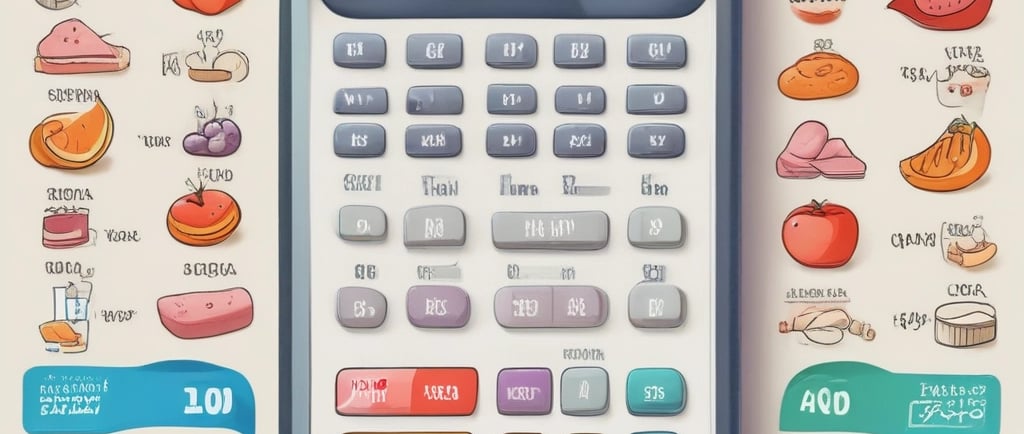Calorie Calculator | Calories To Eat To Lose Weight?
Use our calorie calculator to determine your ideal calorie intake for weight loss. Learn your BMR, TDEE, & macronutrient needs for effective fat loss!


The Ultimate Calorie Calculator Guide: Understanding Your Weight Loss Needs
Losing weight requires understanding your body's energy needs. This comprehensive guide explains how our Calorie Calculator works, defines key terms, and helps you interpret your results for effective weight management.
Key Terms Explained
1. Basal Metabolic Rate (BMR)
Definition: The number of calories your body needs at complete rest to maintain basic functions like breathing, circulation, and cell production.
Why It Matters:
Represents 60-70% of your total daily calorie burn.
Helps determine your maintenance calories.
Varies based on age, gender, weight, and muscle mass.
2. Total Daily Energy Expenditure (TDEE)
Definition: The total calories you burn in a day, including BMR, physical activity, and digestion.
Why It Matters:
Determines how many calories you need to maintain your current weight.
Adjusts based on your activity level (sedentary, active, etc.).
Forms the basis for calculating a calorie deficit.
3. Calorie Deficit
Definition: Consuming fewer calories than your TDEE to promote weight loss.
Why It Matters:
A deficit of 500–1000 calories/day leads to 1–2 lbs (0.5–1 kg) of weight loss per week.
Too large a deficit can cause muscle loss and metabolic slowdown.
Our calculator ensures a healthy, sustainable deficit.
4. Macronutrients (Protein, Carbs, Fats)
Definition: The three primary nutrients that provide energy (calories).
MacronutrientCalories per GramRole in Weight LossProtein4 cal/gPreserves muscle, keeps you fullCarbs4 cal/gProvides energy for workoutsFats9 cal/gSupports hormones and satiety
Why It Matters:
Proper macronutrient balance prevents muscle loss and keeps energy levels stable.
Our calculator suggests a 40% carbs, 30% protein, 30% fat split for balanced weight loss.
How the Calculator Works
Step 1: Enter Your Personal Details
Age & Gender: Metabolism slows with age, and men typically burn more calories than women.
Height & Weight: Used to estimate BMR (taller/heavier bodies burn more calories).
Body Fat % (Optional): Provides a more accurate BMR calculation using the Katch-McArdle formula.
Step 2: Select Your Activity Level
Activity LevelMultiplierDescriptionSedentary1.2Little to no exerciseLightly Active1.375Light exercise 1–3 days/weekModerately Active1.55Moderate exercise 3–5 days/weekVery Active1.725Hard exercise 6–7 days/weekExtra Active1.9Very hard exercise + physical job
Step 3: Set Your Weight Loss Goals
Target Weight: The weight you aim to reach.
Weekly Weight Loss Rate:
0.25–0.5 kg (0.5–1 lb) per week = Mild deficit (sustainable)
0.5–1 kg (1–2 lbs) per week = Moderate deficit (faster results)
>1 kg (2 lbs) per week = Aggressive deficit (not recommended long-term)
Step 4: Get Your Results
After clicking "Calculate Calories," you’ll see:
BMR: Your baseline calorie needs at rest.
TDEE: Your maintenance calories based on activity.
Daily Calorie Target: How many calories to eat for weight loss.
Time to Reach Goal: Estimated duration based on your deficit.
Macronutrient Breakdown: Grams and calories from protein, carbs, and fats.
How to Use Your Results for Effective Weight Loss
1. Track Your Calories
Use apps like MyFitnessPal or Cronometer to log food.
Stick to your daily calorie target for steady progress.
2. Adjust Based on Progress
If weight loss stalls after 2–3 weeks, reduce calories by 100–200/day or increase activity.
If you feel fatigued, increase calories slightly (100–200/day).
3. Prioritize Protein
Aim for 1.6–2.2g of protein per kg of body weight to retain muscle.
Good sources: Chicken, fish, eggs, tofu, Greek yogurt.
4. Combine with Exercise
Strength training helps preserve muscle while losing fat.
Cardio increases calorie burn but shouldn’t replace diet control.
Final Thoughts
This Calorie Calculator takes the guesswork out of weight loss by providing personalized calorie and macronutrient targets. By understanding your BMR, TDEE, and ideal deficit, you can lose fat efficiently without extreme dieting.
Ready to start? Use the calculator above, follow your plan, and watch your progress unfold!
Have questions? Drop them in the comments below! 🚀
Read More:
Explore our extensive range of health calculators.
For Appointments
Get Health insights & OFFERS
support@doseway.com
0318 - 6144650
© 2025. All rights reserved.
